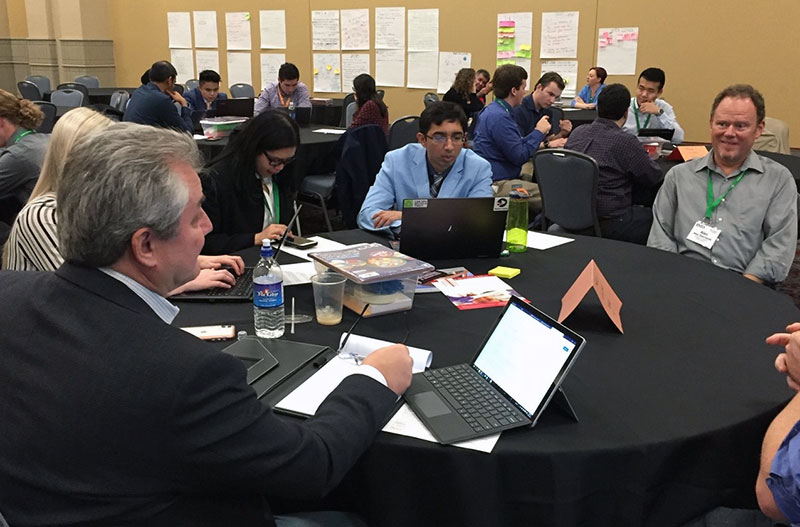Joel Berry, Ph.D., and Alan Eberhardt, Ph.D., of the Department of Biomedical Engineering ran a BlazeDesign Workshop at the 2019 Annual Conference of the Biomedical Engineering Society (BMES), in Philadelphia, Pennsylvania.
 The three-hour, fast-paced activity walked participants through a process of identifying unsolved real-world clinical problems, empathizing with clinical stakeholders, defining the scope of the problem, brainstorming solutions, getting stakeholder feedback, prototyping, and pitching the solution to a “shark tank.” The workshop was based on the design-thinking methodology and used a software tool, UAB Solution Studios, to lower barriers to innovation and drive teams toward viable solutions.
The three-hour, fast-paced activity walked participants through a process of identifying unsolved real-world clinical problems, empathizing with clinical stakeholders, defining the scope of the problem, brainstorming solutions, getting stakeholder feedback, prototyping, and pitching the solution to a “shark tank.” The workshop was based on the design-thinking methodology and used a software tool, UAB Solution Studios, to lower barriers to innovation and drive teams toward viable solutions.
The projects selected were:
- a redesign of the standard hospital bed,
- development of a force-limiting surgical handle for orthopedic surgery,
- improvements for central venous lines,
- an app to monitor patient movement through hospitals.
Participants included 16 students from various universities and eight stakeholders, including industry representatives and clinicians. The workshop embodied real-world innovation and entrepreneurship.
Teams were provided a 12-slide pitch deck template which they used for their pitches to mock investors at the end of the workshop. They were then given an introduction to Design Thinking, which described the five steps of Empathy, Definition, Ideation, Prototyping, and Testing, presented in the context of an unmet clinical need posted to Solution Studios. Teams formed around specific problems, interviewed stakeholders (empathy), found relevant background literature (define), proposed creative solutions (ideate), built crude models of the solution (prototype), and presented the solution to the stakeholders (test).
 Based on clinician interviews and background literature, teams were to develop as many ideas as possible. One team member recorded the ideas and made drawings. The instructors introduced the Pugh Method as a means for quantitative evaluation of design concepts based on design specifications, in order to identify those concepts that have the greatest technical feasibility, patentability, and market potential. Using available materials (basic office and craft supplies) the teams constructed prototypes of their innovations. Physical models represented medical devices, while images depicted on note cards represented apps.
Based on clinician interviews and background literature, teams were to develop as many ideas as possible. One team member recorded the ideas and made drawings. The instructors introduced the Pugh Method as a means for quantitative evaluation of design concepts based on design specifications, in order to identify those concepts that have the greatest technical feasibility, patentability, and market potential. Using available materials (basic office and craft supplies) the teams constructed prototypes of their innovations. Physical models represented medical devices, while images depicted on note cards represented apps.
The stakeholders acted as mock investors for the pitches. Each team had five minutes to present their clinical innovation (three-minute pitch, two-minute Q&A) including the problem, the scale of the problem, product designed to deal with the problem, the market, and the amount of money necessary to get the prototype off the ground. The first-place winners were the team that selected redesign of the hospital bed.
Berry and Eberhardt will hold the workshop again at next year’s BMES meeting in San Diego.